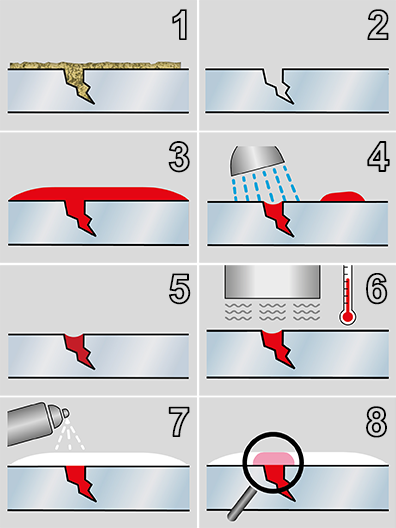Basic Knowledge about Dye Penetrant Testing
Background
Cracks on surfaces that occur during the production of technical components, or pores that may be present mainly in castings and are cut by turning or milling can be made visible by appropriate procedures. Penetrant testing (PT) is one of these methods and a comparatively simple examination method of non-destructive material testing. It is used to indicate surface defects such as pores, cracks, binding defects, laminations and forging laps that are open to the surface.
The main applications are:
- (Mainly) testing of non-ferromagnetic materials
- Mobile inspection of pipelines, boilers and chemical plants
- Testing of light metal and titanium components in aircraft and automobile construction
Advantages of Penetration or Penetrant Methods
- Optional on site use
- Can be used on almost all solid materials, including ceramics or plastics
- Simultaneous testing for surface cracks and pores in one operation
- The procedure is hardly influenced by the geometry of the test specimen
- Low expenditure for testing equipment, therefore cost-effective
Principle
Dye penetrant testing is always used when magnetic particle crack testing (MT) is not possible. So if non-ferromagnetic materials are to be tested or if MT testing cannot be carried out due to on-site conditions, the use of penetrants is the solution.

- Soiled crack
- Ideally pre-cleaned
- Application of test agent
- Intermediate cleaning
- Optimally cleaned intermediately
- Drying
- Application of developer
- Crack indication
First, the soiled area of the workpiece must be cleaned carefully (1 and 2). After cleaning the surface, the penetrant is applied to the area to be tested. The test agent penetrates into existing cracks by capillary action (3). After a penetration time of approx. 10 min (the time varies with the material), the agent is rinsed from the surface, however it remains in the cracks (4 and 5). After drying (6), a white developer is applied thinly (7). Due to the high contrast between the (red) penetrant and the white developer, the cracks are clearly visible. The test agent can also be provided as a fluorescent version, so that the crack indication can be seen with high contrast under ultraviolet light.
Testing in Detail
The three chemicals penetrant, intermediate cleaner and developer need to coordinate and, according to the standard, must only be used as a sample-tested system. Therefore, replacing individual components from the system with components from another system is not permitted.
For larger quantities of components, e.g. with series production, the process can also be semi or fully automated.
Under certain circumstances this method is also suitable for leak testing. If the penetrant is applied on one side of the test part and the developer on the other side, leaks can be detected by penetrant escaping on the developer side and causing an indication there.
Further Information

Further, comprehensive information on the dye penetrant process can be found in our knowledge floater video “Dye Penetrant Process”.

